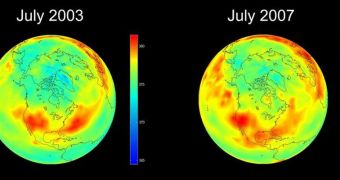According to the United Nations, the non-binding pledges that nations made following the failed Copenhagen climate summit are insufficient to prevent an increase of two degrees Celsius in global temperatures over the coming century. Some 60 countries have submitted their emission-reduction targets to the UN as per the agreement signed last December, but a new model released today by the UN shows that these pledges are insufficient to avoid disaster, Reuters reports.
The current belief is that the global increase in the surface temperatures needs to be kept below two degrees Celsius in comparison with pre-industrial levels. This would ensure that the catastrophic consequences of climate change will not hit some of the poorest nations in the world, as well as coastal regions, which currently host a large percentage of the global population. The two largest megalopolises in the world, the one including Boston, New York, Philadelphia and Washington, and the one made up of Tokyo, Osaka and Nagoya, are next to oceans. Together, they house 135 million people.
The recent model, which was released by the United Nations Environment Program (UNEP), shows that carbon-dioxide emissions should not exceed 48.3 gigatonnes by 2020. It estimates that a peak in emissions would be reached sometime between 2015 and 2020. Even if nations somehow manage to get past their interests and come to an understanding in due time, massive cuts are required in order to give the Earth a 50-50 chance of not exceeding the temperature threshold. A 48- to 72-percent cut in CO2 levels between 2020 and 2050 will ensure that the planet gets a fair chance, but the model offers no guarantees that this will be enough. The recent report was based on data sets collected from nine distinct sources, UN officials say.
“The expected emissions for 2020 range between 48.8 to 51.2 gigatonnes of CO2-equivalent, based on whether high or low pledges will be fulfilled,” the report says. The numbers are based on the targets that the 60 nations that pledged cuts set for themselves. “The message is not to sit back and resign and say we will never make it. But it's not enough at the moment and there are other options that can be mobilized,” Achim Steiner, the executive director of UNEP, has told reporters. “It has been estimated that putting $22 billion to $29 billion into REDD [reduced emissions from deforestation and degradation] would cut global deforestation by 25 percent by 2015,” the report adds.

 14 DAY TRIAL //
14 DAY TRIAL //